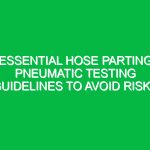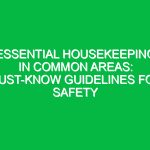“`html
Essential Housekeeping Guidelines: Avoid These Critical Safety Risks
Introduction
Good morning team! Today, we’re going to discuss an essential aspect of Workplace Safety—housekeeping. The purpose of this Toolbox Talk is to highlight the importance of maintaining a clean and organized work environment and how it can prevent critical safety risks. A well-maintained workspace not only boosts productivity but also significantly reduces the chances of accidents and injuries.
Why is this topic so important? Poor housekeeping can lead to slips, trips, and falls, which are among the leading causes of workplace injuries. So, let’s dive into the essential housekeeping guidelines that will help us all stay safe and healthy!
Understanding Essential Housekeeping Guidelines
Essential housekeeping guidelines refer to practices that ensure our workspaces are clean, orderly, and safe. This includes proper storage, waste disposal, and maintaining clear pathways. When employees adhere to these guidelines, it significantly reduces Hazards that could lead to accidents.
Housekeeping is not just about aesthetics; it’s about creating a safe environment. Many employees might think that a little clutter here and there won’t cause harm, but even small messes can lead to serious safety risks. Remember, a clean workplace is a safe workplace!
Key Hazards, Risks, and Safety Considerations
Let’s identify some specific hazards associated with poor housekeeping:
- Slips, Trips, and Falls: These are the most common accidents caused by clutter, spills, or uneven surfaces.
- Fire Hazards: Accumulated waste, especially flammable materials, can lead to dangerous Fires.
- Injury from Improper Storage: Items stored improperly can fall and injure employees.
- Health Issues: Dust and debris can contribute to respiratory problems or allergic reactions.
Ignoring these hazards can have real-world consequences, such as workplace injuries that could be prevented with simple housekeeping practices. Let’s think about the last time someone had to deal with a spill or clutter. What happened? Was it a simple fix, or did it lead to a more serious issue?
Best Practices, Procedures, & Actionable Advice
Now that we’ve identified the risks, let’s discuss Best Practices for effective housekeeping:
- Maintain Clear Pathways: Always ensure that walkways are free of obstructions. This includes cords, boxes, and any other items that could cause someone to trip.
- Proper Storage: Store items in designated areas. Use shelves, cabinets, and bins to keep materials organized and off the floor.
- Regular Cleaning: Establish a cleaning schedule that includes daily, weekly, and monthly tasks. Assign responsibilities to ensure everyone contributes.
- Handle Spills Immediately: If something spills, clean it up right away to prevent slips. Use appropriate cleaning materials and signage to warn others.
- Dispose of Waste Properly: Use designated waste bins and ensure that flammable materials are disposed of in compliance with safety protocols.
Let’s consider a real-world scenario: a coworker slips on a wet floor because a spill was not cleaned up immediately. This could lead to a serious injury, not to mention potential downtime and increased insurance costs. By following these Best Practices, we can prevent such incidents.
Regulations, Standards, and Compliance
Understanding the Regulations and Standards related to housekeeping is crucial. The Occupational Safety and Health Administration (OSHA) sets regulations that require employers to provide a safe workplace. This includes maintaining clean and orderly spaces.
Compliance with these standards is not just about avoiding fines; it’s about protecting ourselves and our coworkers. When we adhere to these guidelines, we create a safer environment that Benefits everyone.
Employee Engagement & Discussion
Now, I want to hear from you. What safety challenges have you encountered related to housekeeping? Have you seen instances where better housekeeping could have prevented an accident? Sharing our experiences helps us learn from one another and fosters a culture of safety.
Conclusion & Key Takeaways
To wrap up, let’s summarize the main points:
- Housekeeping is crucial for Workplace Safety.
- Ignoring housekeeping can lead to serious injuries and hazards.
- Implementing best practices can significantly reduce risks.
- Compliance with safety regulations is essential for a safe work environment.
Remember, safety starts with each one of us. By prioritizing housekeeping, we can create a safer and more productive workplace. Thank you all for your attention and your commitment to maintaining a safe work environment. Let’s keep safety at the forefront of our daily operations!
“`


